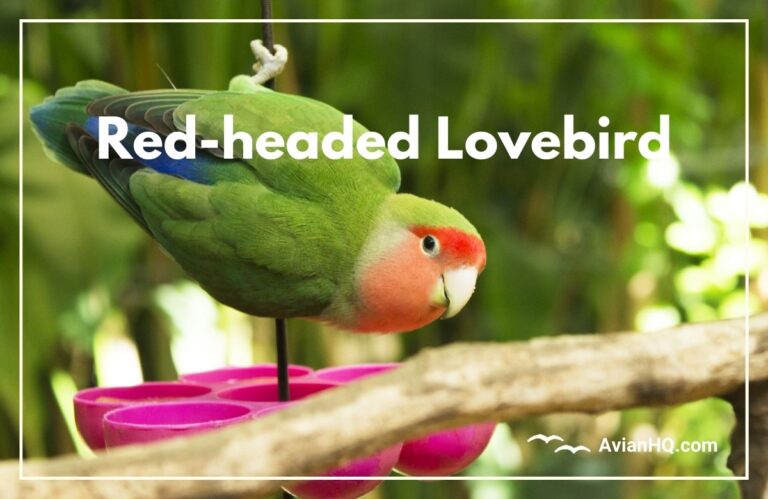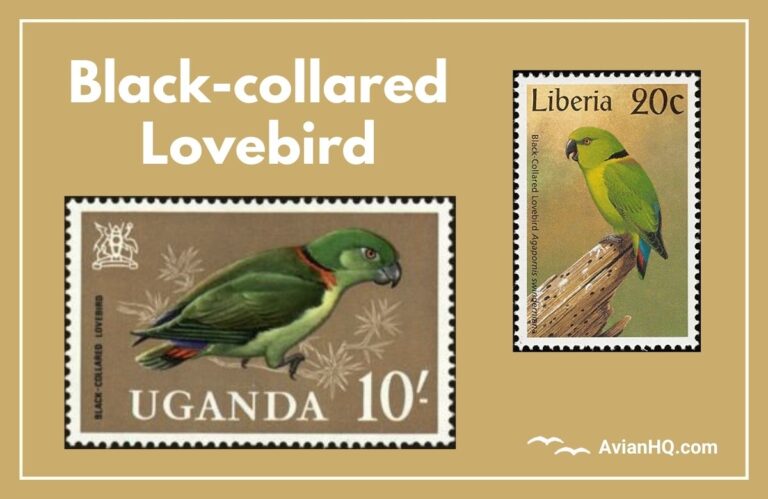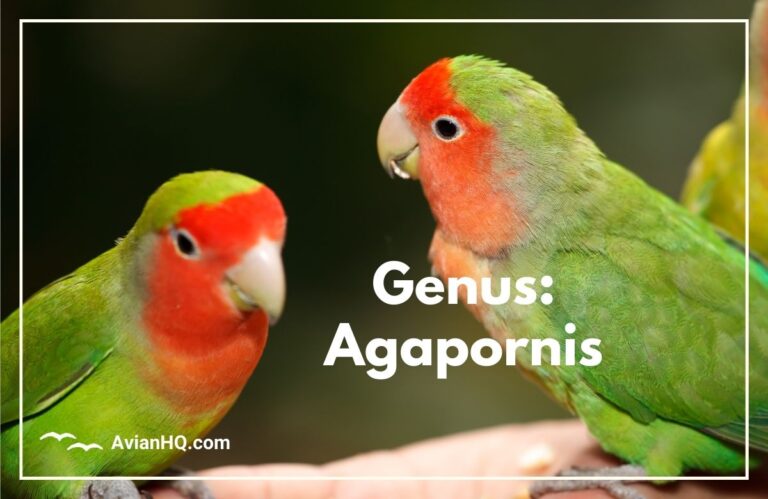Lilian’s Lovebird (Agapornis lilianae)
Have you ever seen a small, vibrant green parrot with a bright orange head and wanted to learn more about that beautiful bird? If so, you may have spotted the Lilian’s Lovebird (Agapornis lilianae), one of Africa’s most colorful and charismatic little parrots.
These petite parrots stand at just 13 centimeters (5 inches) tall yet pack huge personality into their small frames. With emerald bodies and fiery orange feathers decorating their heads and chests, Lilian’s Lovebirds showcase a stunning contrast of colors. As their name suggests, Lilian’s Lovebirds form strong pair bonds between mates, lending an air of romance to these affectionate little birds.
Lilian’s Lovebirds hold significance for conservationists and bird enthusiasts alike. Their restricted habitat range and specialized diet make them vulnerable to population decline, earning them a Near Threatened designation on the IUCN Red List. However, relatively little research exists on the behavior and ecology of these species in the wild.
This article will provide an in-depth look at the natural history of Lilian’s Lovebirds, including their origins, physical features, habitat preferences, breeding behaviors, current conservation status, and cultural importance across their native lands in southeast Africa. Read on to learn more about one of the continent’s most endearing little parrots!
History and Taxonomy
The Lilian’s Lovebird’s scientific name honors Lilian Sclater, wife of the British zoologist William Sclater who first described the species in 1894. He named the bird Agapornis lilianae in her honor.
These parrots remained largely unknown to science until Sclater’s discovery of them in the 19th century. Since 1894, researchers have documented few significant updates to the Lilian’s Lovebird’s scientific classification. This species has no known subspecies at present. Scientists categorize all existing populations as the nominate Agapornis lilianae with no further division into geographically distinct groups.
However, new genetic analyses may reveal hidden diversity within scattered wild populations of Lilian’s Lovebirds in the future. Their remote habitat range across southern Africa limits researchers’ access and ability to study these birds consistently. Thus, further field studies may uncover evidence to justify defining subspecies in the future based on morphological, behavioral, or genetic distinctions between different populations.
For now, all Lilian’s Lovebirds across Zambia, Malawi, Tanzania, Mozambique, and Zimbabwe belong to the single species Agapornis lilianae. Their scientific name translates to “love bird,” an apt description for these strongly bonded parrots.
Physical Appearance
The Lilian’s Lovebird cuts a petite but vivid figure thanks to its contrasting green, orange, and white plumage. These petite parrots measure just 13 centimeters (5 inches) long from beak tip to tail tip. Their bodies weigh an average of 28-37 grams (1.0-1.3 ounces).
Vibrant green feathers cover most of the body from the nape down. Bright orange plumage decorates the forehead, crown, face, chin, and upper chest before fading into a vibrant salmon-pink hue. The upper tail coverts are also green.
Thin white eyerings of bare facial skin encircle each eye. These eyerings help distinguish Lilian’s from similar lovebird species like Fischer’s Lovebird. The short tail consists of green feathers banded with yellow-orange edges.
Males and females look identical with no sexual dimorphism in plumage or size. Both sexes sport the same vibrant green, orange, and white color pattern.
In comparison, young juvenile Lilian’s Lovebirds appear slightly duller overall, with smudgy dark feather edging around their facial area. Their upper mandibles are blackish at the base rather than the solid red of adult beaks. Once they mature and molt into adult plumage, these physical differences disappear.
Habitat and Distribution
Lilian’s Lovebirds reside in a relatively small swath of southeast Africa consisting primarily of Zambia, Malawi, Tanzania, Mozambique, and Zimbabwe. Their native habitat lies at elevations up to 1,000 meters (3,280 feet) above sea level.
These parrots largely stick to two major habitat types:
- Mopane woodlands: Characterized by tall mopane trees in hot, low-lying valleys
- Acacia woodlands: Drier woodlands populated by short acacia trees
Lilian’s Lovebirds also frequent riparian forests along rivers and streams. They especially appreciate river valleys lined with fig trees. The figs provide a bountiful food supply while the trees offer nesting cavities.
While most populations reside inside conservation areas like Liwonde National Park in Malawi, Lilian’s Lovebirds also occupy fragmented forest reserves surrounding agricultural land. Ongoing habitat loss continually shrinks and isolates these reserves from protected areas though.
An introduced population may also exist in the Lundazi district of Zambia. However, little documentation exists on this outlier group’s origins or success integrating with native species.
Diet and Feeding
Lilian’s Lovebirds enjoy a diverse herbivorous diet centered around seeds, cereals, vegetation, and fruit. These small parrots forage both in trees and on the ground for food.
Some key components of their diet include:
- Seeds & cereals: grass seeds, millet, wild oats, sorghum
- Fruits: figs, apples, pears, oranges, pomegranates, bananas
- Vegetation: flowers, leaf buds, seed pods
Lilian’s Lovebirds supplement this produce-based diet with occasional insects and grit to aid digestion. Their preferred natural foods provide plentiful nutrition when available.
However, these birds will also opportunistically raid agricultural fields. Flocks often gather to feed on cultivated corn, rice, wheat, and fruit crops when possible. This leads to conflict with human farmers.
Feeding behaviors also differ between breeding and non-breeding birds. Monogamous pairs often participate in courtship feeding, in which mates take turns feeding each other berries and choice morsels. In contrast, large communal flocks tend to descend rapidly on plentiful food sources in a feeding frenzy.
Breeding and Reproduction
The breeding season for Lilian’s Lovebirds varies across their habitat range but generally peaks between January and March. Some birds produce second broods around June and July as well.
These parrots nest inside tree cavities, using holes and crevices in live trees or abandoned arboreal termite mounds. They may also repurpose old weaver bird nests built in trees or shrubs.
To construct their nest, Lilian’s Lovebirds peel bark strips and gather twigs and stems as building materials. The female then assembles these pieces into a domed structure with walls up to 2 inches (5 cm) thick. She leaves a side entrance tube to access the inner chamber. Both parents help line the interior with soft grasses and feathers.
When ready to lay, the female produces clutch sizes ranging from three to eight eggs. She incubates these small white eggs alone for an average of 22 days until they hatch.
Both parents share feeding duties to raise the chicks once they emerge. The young birds fledge at around 44 days old, leaving the nest as fully feathered young parrots. However, they may continue roosting in the nest cavity alongside their parents for several days more while learning to forage independently.
Behavior and Ecology
Lilian’s Lovebirds showcase highly social behaviors across all life stages. They spend virtually all their time in the company of other lovebirds. Even monogamous breeding pairs integrate into larger flocks when not actively nesting.
These naturally gregarious parrots form dynamic flocks of 20 to 100+ birds on average. However, congregations in areas with abundant food sources may attract up to several hundred individuals across multiple pairs and families. Lilian’s Lovebirds constantly vocalize with soft chirps and twitters to maintain contact while fuelling their high metabolisms.
When not breeding, Lilian’s Lovebirds sleep in communal roosts inside tree cavities. Up to five birds may pack tightly into a tree hollow, Using their tail feathers like props to keep from toppling over. Before sleeping, the flock engages in lively squabbling and chasing displays to establish a pecking order over preferred roosting spots.
These parrots forage primarily in the mornings and evenings in small groups. They forage both in trees and on open ground, using their strongly hooked beaks to extract otherwise hard-to-reach seeds and grain. Strong legs and feet allow them to cling easily to stalks and vertical surfaces while feeding. Peaceful by nature, Lilian’s Lovebirds may feed alongside other seed-eating bird species with minimal conflict thanks to plentiful food sources.
Conservation Status
Due to ongoing population declines and habitat loss, the IUCN Red List categorizes Lilian’s Lovebirds as Near Threatened. Scientists estimate only 10,000 to 20,000 of these birds remain in the wild.
Major threats contributing to their vulnerable status include:
- Habitat loss: Deforestation and agricultural expansion severely reduce available habitat
- Persecution: Farmers view the birds as pests and poison or shoot them
- Capture: Trapping for the pet trade exports thousands internationally
- Environmental threats: Drought, flooding, and pollution also impact some populations
Lilian’s Lovebirds face a dire outlook without expanded conservation interventions. Liwonde National Park in Malawi shelters the largest remaining population with an estimated 4,000 birds. But even this protected stronghold suffers from extreme habitat degradation and lacks connectivity to other forest refuges.
Some initial conservation actions aimed at stabilizing numbers include:
- Increased legal protections and habitat preserves
- Supplemental nest boxes to replace lost nesting cavities
- Community education programs to reduce persecution
- Crackdowns on unsustainable live capture for the pet trade
However, Lilian’s Lovebirds remain at risk without more robust habitat corridors and enforcement against poaching across their range. Captive breeding programs may serve as an insurance population if wild numbers continue dwindling.
Cultural Significance
The isolated distribution and specialized habitat needs of Lilian’s Lovebirds limit widespread cultural significance for these parrots. Local indigenous groups likely valued them as colorful harbingers of the rainy season and for the seed crops they transported. Their beauty and bonds between mates also sparked admiration.
However, the lovebirds’ tendency to raid grain fields and orchards certainly drew farmers’ ire at times. Some communities still view Lilian’s Lovebirds as agricultural pests and threats to livelihoods. But traditional practices of sustainable harvesting and controlled burns maintained balance between farmland and wildlife.
Lilian’s Lovebirds garnered international attention primarily in conservation circles once scientists documented their population decline. ornithologists and birdwatchers especially value sightings of the vivid lovebirds. For example, wildlife tourists travel to Malawi and Zambia expressly to spot Lilian’s Lovebirds inside forest preserves.
Still, more cultural studies focused on the lovebirds would prove valuable for conservation planning on community levels. Outreach efforts rely on emphasizing Lilian’s Lovebirds as sources of ecological pride rather than frustration. Their beauty and fierce bonds can inspire support for Habitat protection locally and globally.
Conclusion
The stunning plumage and affectionate bonds of the Lilian’s Lovebird offer mere glimpses into the wonders of this threatened African parrot. As one of the continent’s smallest parrots measuring just 13 centimeters (5 inches) long, Lilian’s Lovebirds make up for their petite stature with huge flocks and dynamic behaviors. Deep green and vibrant orange feathers distinguish these social birds who mate for life and share parenting duties equally.
However, the dual threats of habitat loss and poaching have landed Lilian’s Lovebirds an uncertain future. From scattered treetop habitats across southeast Africa to the halls of global conservation summits, scientists and wildlife advocates are banding together to preserve these charming parrots. Their continued survival may hinge on extensive habitat protections and community support for nature in one of the world’s fastest growing human population centers.
If conservation efforts succeed, the musical chatter of Lilian’s Lovebird flocks may continue brightening African skies for generations to come. Their beauty and bonds have already won them devoted fans around the globe rooting for their perseverance.







